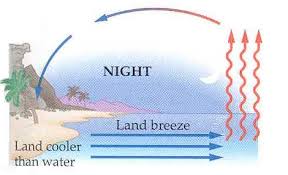

Once developed, these thunderstorms moved slowly northeast, under the influence of the southwest winds blowing in the middle and upper atmosphere. A line of cumulus clouds developed along the length of the peninsula with isolated thunderstorms, as can be seen from the very strong echoes on the radar scan (left). By midday, sea breezes of about 10 knots (20 km/hr) were blowing towards the centre of the Auckland peninsula from each coast. This happens over the Florida peninsula, and also over Auckland and Northland.Īn example of this occurred on Friday February 26, this year. Sometimes two sea breezes moving inland from opposite coasts of a peninsula will give rise to a line of thunderstorms where they meet in the middle. The Greek fleet under the Athenian admiral Themosticles is thought to have used sea breeze fluctuations to their advantage when they defeated a much larger Persian fleet in the battle of Salamis in 479 BC. Knowledge of these sorts of changes in a developing sea breeze may have played a vital role in the history of western civilisation. In the case of the Manukau, this is the southwest. However, after a while, one direction usually prevails in response to the predominate distribution of land and sea. Over an enclosed piece of water such as the Manukau harbour, the sea breeze begins blowing everywhere perpendicular to the beach. a westerly sea breeze blowing on to a west coast will gradually tend southwest during the afternoon, while an easterly sea breeze on an east coast tends northeast. This causes its direction to change slowly in an anticlockwise direction in the southern hemisphere. As its length or “fetch” increases, it begins to be influenced by the Earth’s rotation. Also, this wind will often bring a layer of cloud in over the land, thus reducing the sunlight reaching the land surface.Īs the sea breeze develops, it reaches further out to sea and penetrates further inland. this can suppress the sea breeze, either weakening it or preventing its development. If the pre-existing wind at 1000 metres is blowing from sea to land. However, if the preexisting wind is too strong, it will prevent the sea breeze developing. This can happen at Nelson in a southwest airstream when the sea breeze can come in abruptly at 25 knots (45 km/hr). this generally helps the sea breeze circulation and brings the sea breeze in earlier and more strongly than would otherwise be the case. If there is a pre-existing wind from land to sea at 1000 metres. So it is often stronger in late spring and early summer than in late summer or autumn, because the sea temperatures are warmer in autumn than in spring.

Its strength depends on the temperature contrast between land and sea. The sea breeze usually starts up late morning and drops off around dusk. This circular air movement-up over land, out to sea aloft, down over the sea, then back in over the land at sea level-is called the sea breeze circulation. So, down at mean sea level, the atmospheric pressure is now a little higher over the sea than over the land, and air begins to move from the sea over the land. Consequently, air at this altitude begins to flow away from the land and towards the sea.īut this means that there is now more air in total in the column over the sea than in the column over the land. This means that along a horizontal surface at 1000 metres altitude, the pressure above the land has become a little higher than it is over the sea. So, for example, the height at which the atmospheric pressure is 900 hPa (which is usually about 1000 metres above mean sea level) will now be a little higher over the land than over the sea.

This has the effect of lifting the centre of gravity of the column of air vertically above the land in comparison with the column of air above the sea. As the air in the lowest 1000 metres gradually warms up, it expands. This air then rises and mixes with the air above.

Once the land heats up, it warms the air immediately above it by conduction. Daytime temperatures can often reach 10 ☌ higher than the overnight minimum temperature. The land, however, heats up comparatively quickly-especially asphalt and concrete. Consequently, the sea surface temperature does not rise much during the day. When sunlight warms the sea surface, some of the heat is conducted away to water below, and also some mixing of the water occurs. It is caused by the different responses of land and water to heating by the sun’s radiation.


 0 kommentar(er)
0 kommentar(er)
